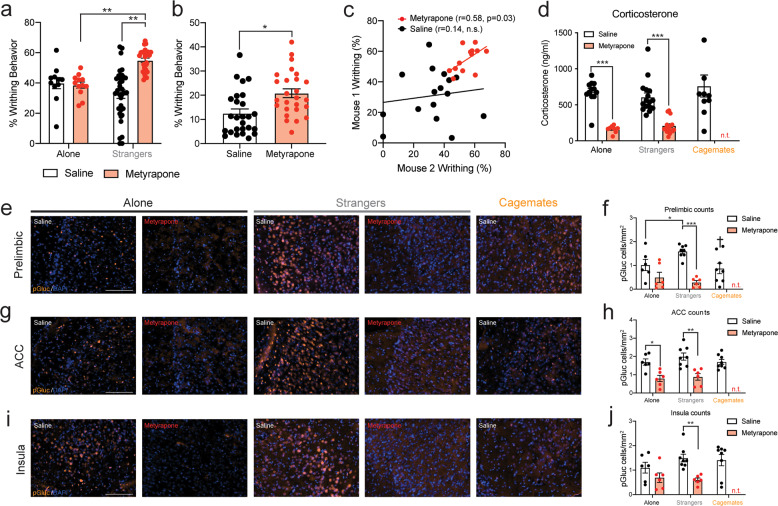Fig. 2. Inhibition of the HPA-stress axis induces pain contagion in stranger mice and reduces glucocorticoid activity in the prelimbic cortex.
a Metyrapone (50 mg/kg), enhances writhing behavior in mice tested in stranger dyads (n = 26), when compared with vehicle-treated dyads (n = 32) and mice tested alone, both vehicle-treated (n = 11) and metyrapone-treated (n = 12) (two-way ANOVA, main effect of drug: F1,77 = 1.76, p > 0.05; main effect of social context: F1,77 = 12.28, p < 0.001; social context × drug interaction: F1,77 = 15.41, p < 0.001). b Higher co-occurrence of writhing behavior in metyrapone-treated compared with vehicle-treated dyads. Using data from a, the expected number of samples with writhing in both mice of the dyad was calculated as a joint probability. Bars represent the mean ± SEM of episodes of joint writhing expressed as a percentage (independent samples t-test, t50 = 3.25, p < 0.01). c Writhing behavior is significantly correlated between mice within metyrapone-treated (r = 0.58, p = 0.03), but not vehicle-treated dyads (r = 0.14, n.s). d Blood plasma corticosterone is similar between mice tested alone (n = 12), with a stranger (n = 16) or with a cagemate (n = 10) (one-way ANOVA, F2,35 = 0.79, p > 0.05). However, metyrapone significantly reduced blood plasma corticosterone in mice tested alone (n = 9) and stranger dyads (n = 16) (two-way ANOVA, main effect of drug: F1,51 = 102.2, p < 0.001; main effect of social: F1,51 = 0.08, p > 0.05; social context × dug interaction: F1,51 = 1.72, p > 0.05). e Representative images showing phosphorylated glucocorticoid receptor (p-GR) staining in the prelimbic cortex for mice tested alone or within a saline-treated or metyrapone-treated stranger dyad. A representative image for the cagemate condition is also shown. f p-GR (p-GR cells/mm2) staining in the prelimbic cortex is higher in stranger (n = 8) compared with cagemate dyads (n = 8) (one-way ANOVA, F2,19 = 4.339, †p < 0.05 compared with stranger dyads). p-GR staining in the prelimbic is significantly reduced by pre-treatment with metyrapone in stranger dyads, but not mice tested alone (two-way ANOVA, main effect of drug: F1,22 = 31.06, p < 0.001; main effect of social: F1,22 = 1.16, p > 0.05; social context × drug interaction: F1,22 = 5.72, p < 0.01). g Representative images showing p-GR staining in the anterior cingulate cortex (ACC) for mice tested alone or within a saline- or metyrapone-treated stranger dyad. A representative image for the cagemate condition is also shown. h p-GR staining in the ACC is similar between mice tested alone or within a stranger or cagemate dyad (one-way ANOVA, F2,19 = 1.02, p > 0.05). Metyrapone significantly reduced p-GR staining in the ACC of mice tested alone (n = 6) or with a stranger (n = 8) (two-way ANOVA, main effect of drug: F1,22 = 29.20, p < 0.001; main effect of social context: F1,22 = 1.06, p > 0.05; social context × drug interaction: F1,22 = 0.32, p > 0.05). i Representative images showing p-GR staining in the insular cortex for mice tested alone or within a saline-treated or metyrapone-treated stranger dyad. A representative image for the cagemate condition is shown for comparison. j p-GR staining in the insula is similar between mice tested alone or within a stranger or cagemate dyad (one-way ANOVA, F2,19 = 0.91, p > 0.05). Metyrapone significantly reduced p-GR staining in the insula of mice tested alone and within a stranger dyad (two-way ANOVA, main effect of drug: F1,22 = 14.18, p < 0.001; main effect of social context: F1,22 = 0.75, p > 0.05; social context × drug interaction: F1,22 = 1.99, p > 0.05). For two-way ANOVA cagemates were not included in the analyses because the experimental design did not include a metyrapone-treated cagemate group, a decision made based on previous work [11]. Scale bars = 100 μM. *p < 0.05, **p < 0.01, ***p < 0.001.

